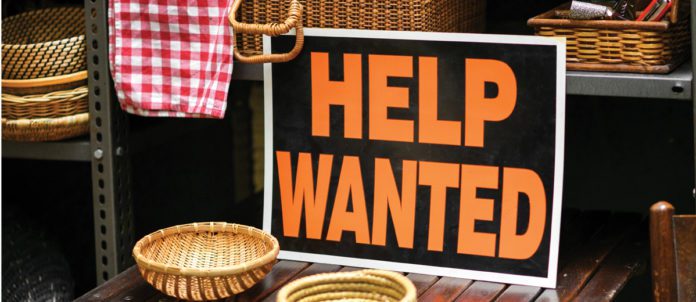The restaurant industry has been one of the hardest hit during the pandemic, as closures and restrictions quickly eroded cash flow and bottom lines. Now, as restrictions loosen across the country and restaurants re-open, the growing labour shortage is creating a new set of challenges for restaurants.
Despite being able to re-open, restaurants are scrambling to fill positions and re-build employee rosters to get back to where they were pre-pandemic. With restrictions lifting for the first time in more than a year, restaurants are struggling to keep up with the demand as excited guests return to dining.
However, unlike the infamous labour shortage of 2018, restaurants are now better equipped to fill the gaps. After a year-and-a-half of uncertainty, many restaurants have implemented new technology that helps streamline operations, reduce waste and ultimately lead to a better environment for staff and guests.
The Loss of Labour
At the onset of the pandemic, restaurants were among the first businesses to face immediate and long-lasting closures, spurring a wave of layoffs that rocked the industry. As the pandemic continued, many restaurant workers left the industry for good, opting for jobs with more security or those that offered remote-working options. Of the workers who did stay, many have been uneasy about returning while case counts continue to fluctuate. This combination has resulted in an ongoing labour shortage with no end in sight.
These hiring challenges are only expected to persist as restaurants struggle to compete for talent. As more roles open up, restaurant workers have more options available to them — meaning restaurant owners have to work harder than ever to attract and retain talent, and one misstep could discourage employees from sticking around. To overcome these challenges, restaurants are looking for alternative ways to cope with being short staffed, exploring new ways to recruit employees and unique incentives to support retention.
Technology as the New Co-worker
The pandemic has undoubtedly turned the restaurant industry upside down and technology has stepped in to provide a silver lining. While many operators were exploring new technology solutions to improve operations before early 2020, the pandemic has accelerated this search, with many expediting their search and implementation of new tech from a three-year to a three-month plan in order to meet the needs of the quick pivot to online-only business.
Amid the widespread closures, restaurants saw a spike in demand for online ordering, pickup and delivery as lockdowns prohibited guests from dining in. Operators responded by implementing technology that streamlines ordering, payment and order fulfillment for this new online-only audience. As restaurants begin to re-open, technology such as online-ordering systems, order and pay-at-the-table functions, and digital loyalty programs will play a pivotal role for both online ordering and in-house operations.
First, the technology will enable restaurants to continue servicing online orders, either directly through their website or through third-party delivery platforms, at a higher capacity than ever before. While online ordering is anticipated to drop from its pandemic levels, lockdowns did spur a new wave of digital diners that will likely continue to leverage the convenience of online ordering.
Second, the in-house tech will help alleviate some of the pressure on servers, allowing them to focus on aspects that the technology can’t provide to the guest, such as human interaction, personalized recommendations and a customized dining experience. Rather than running back to the POS workstation to input orders, which can be incredibly time consuming and take away from the customer experience, technology, such as handheld ordering tablets and QR-code enabled ordering, allows servers to spend their time more thoughtfully and efficiently. This provides a unique experience for each guest and builds relationships to encourage repeat visits and strengthen loyalty.
Not only does technology allow servers to spend their time more efficiently, it’s also beneficial to the back-of-house team. With advanced kitchen display systems (KDS), the back-of-house staff is able to increase its efficiency. A digital KDS streamlines the bustling, and sometimes hectic, back-of-house processes as it reduces human error and provides extra support for the cooks.
While a chit system works for some restaurants, an advanced KDS has a built-in system that lets the cooks know when to prepare their dishes so that each dish is ready at the right time. As restaurants look to fill back of house roles with more junior staff, the KDS technology alleviates pressure in the back of house, while increasing efficiency, decreasing errors and food waste and ultimately provides guests with a consistent and positive experience.
Competing for Top Talent
Restaurants are currently facing a competitive landscape that makes it difficult to not only hire bodies to fill the roles, but to find high-calibre employees who will genuinely care about the well-being and success of the restaurant. In order to compete for top talent, operators must go beyond simply providing a good working environment — they must also get creative in their recruitment efforts.
Some restaurants are implementing more robust referral programs, offering financial incentives to their workforce in order to find new talent, while others are expanding their horizons when looking to fill roles. For example, we’ve seen restaurants fill chef roles with line cooks, enabling them to train the cook following the restaurant’s own best practices while supporting overall industry growth. This tactic works particularly well when kitchens are equipped with kitchen display systems that help guide kitchen staff step by step to ensure meals are prepared perfectly every time.
Lastly, but probably most importantly, it is vital that restaurants offer not only competitive wages, but also benefits to employees. Following the turmoil from the past year, prospective employees are concerned, now more than ever, about their health and want to ensure they are properly protected. The ability to visit a healthcare professional without paying for the cost out of their own pocket has become a non-negotiable.
A Clean Slate
While the past year has been one of the most difficult the restaurant industry has ever faced, the industry’s resilience has resulted in several incredible innovations as we move into a post-pandemic world. Restaurant owners and operators have used this opportunity to implement new technology to create a better and more efficient working environment, setting up the industry for long-term success.
Mo Chaar is the Chief Commercial Officer of Givex, where he oversees commercial strategy and development worldwide as well as managing sales teams within North America. His experience in gift card, loyalty, and POS has played a pivotal role in the success of some of Givex’s largest partners.





















